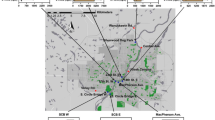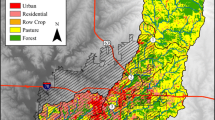Abstract
Dry-season urban runoff from watersheds in arid regions can contribute substantial concentrations and loads of bacteria and metals to downstream receiving waters. However, there are few studies that have evaluated the relative contributions of different sources of these constituents along a specific creek or channel. This study involved analysis of the relative contribution of various storm drain sources to the total dry-season loading of metals and bacteria in the Ballona Creek (California) watershed. Approximately 40 actively flowing storm drains and 12 in-river sites were sampled three times during the spring and summer of 2003 for flow, total and dissolved metals, and bacteria. These data were analyzed in terms of mean concentration and load, temporal variability, and spatial distribution of substantial inputs to the creek. In general, Ballona Creek exhibited a bimodal distribution of elevated metals and bacteria, corresponding to locations where storm drains with consistently high concentrations and loads discharge to the creek. Of the 40 drains sampled, 4 accounted for 85% of the daily storm drain volume. Between 91% and 93% of the total daily load for metals was contributed by eight drains, while nine drains consistently had the highest concentrations of metals and bacteria. Metals concentrations were observed to vary by up to five-fold and bacterial counts by up to five orders of magnitude on an intra- and inter-annual basis. However, despite this variability, a relatively small number of storm drain inputs can be expected to account for the majority of loading.
Similar content being viewed by others
References
American Public Health Association (APHA): 2000, Standard Methods for the Examination of Water and Wastewater, 20th Edition, American Water Works Association, American Public Health Association, and Water Environment Federation, Philadelphia, PA., pp. 1220.
Ackerman, D., Schiff, K., Trimm, H. and Mullin, M.: 2003, ‘Characterization of water quality in the Los Angeles river’, Bulletin of the Southern California Academy of Sciences 102, 17–25.
Davis, A. P., Shokouhian, M. and Shubei, N.: 2001, ‘Loading estimates of lead, copper, cadmium, and zinc in urban runoff from specific sources’, Chemosphere 44, 997–1009.
McPherson, T. N., Burian, S. J., Turin, H. J., Stenstrom, M. K. and Suffet, I. H.: 2002, ‘Comparison of the pollutant loads in dry and wet weather runoff in a southern California urban watershed’, Water Science and Technology 45, 255–261.
Piechota, T. C. and Bowland, L.: 2001, ‘Characterization of Wet and Dry Flows from Urban Runoff in an Arid Region’, Paper presented at the Environmental and Water Resources Institute Conference on Urban Drainage Modeling, Orlando, FL. pp. 195.
Porcella, D. B. and Sorenson, D. L.: 1980, ‘Characteristics of Nonpoint Source Urban Runoff and its Effects on Stream Ecosystems’, EPA-600/3-80-032. United States Environmental Protection Agency, Corvallis, OR., pp. 99.
Roesner, L. A. and Bledsoe, B. P.: 2003, ‘Physical Effects of Wet Weather Flows on Aquatic Habitats: Present Knowledge and Research Needs’, Water Environment Research Foundation Technical Report # 00-WSM-4. Alexandria, VA., pp. 197.
Schueler, T. R.: 1994, ‘The importance of imperviousness’, in T. R. Schueler and H. K. Holland (eds.), 2000, The Practice of Watershed Protection, Watershed Protection Techniques, Ellicott City, MD: Center for Watershed Protection, pp. 100–111.
Simpson, J. M., Domingo, J. W. S. and Reasoner, D. J.: 2002, ‘Microbial source tracking: State of the science’, Environmental Science and Technology 36, 5279–5288.
Sokal, R. R. and Rohlf, F. J.: 1969, Biometry: The Principles and Practice of Statistics in Biological Research, W.H. Freeman and Company, San Francisco, CA., 776 pp.
Stein, E., Ackerman, D. and Schiff, K.: 2003, ‘Watershed-based Sources of Contaminants to San Pedro Bay and Marina del Rey: Patterns and Trends’, Southern California Coastal Water Research Project Technical Report #413, Westminster, CA., 31 pp.
Suffet, I. H. and Stenstrom, M. K.: 1999, ‘A study of pollutants from the Ballona Creek watershed during wet-weather flow’, Final Report to U.S. Army Corps of Engineers, UCLA, Los Angeles, California.
United States Environmental Protection Agency (U.S. EPA): 1983, in ‘Methods for Chemical Analysis of Water and Wastes’, EPA-600/4-79-020. United States Environmental Protection Agency. Cincinnati, OH., U.S.A., pp. 552.
United States Environmental Protection Agency (U.S. EPA): 1995, ‘National Water Quality Inventory: 1994 Report to Congress’, EPA/841/R-95/005. United States Environmental Protection Agency. Washington, DC., pp. 572.
Author information
Authors and Affiliations
Corresponding author
Rights and permissions
About this article
Cite this article
Stein, E.D., Tiefenthaler, L.L. Dry-Weather Metals and Bacteria Loading in an Arid, Urban Watershed: Ballona Creek, California. Water Air Soil Pollut 164, 367–382 (2005). https://doi.org/10.1007/s11270-005-4041-0
Received:
Accepted:
Issue Date:
DOI: https://doi.org/10.1007/s11270-005-4041-0




